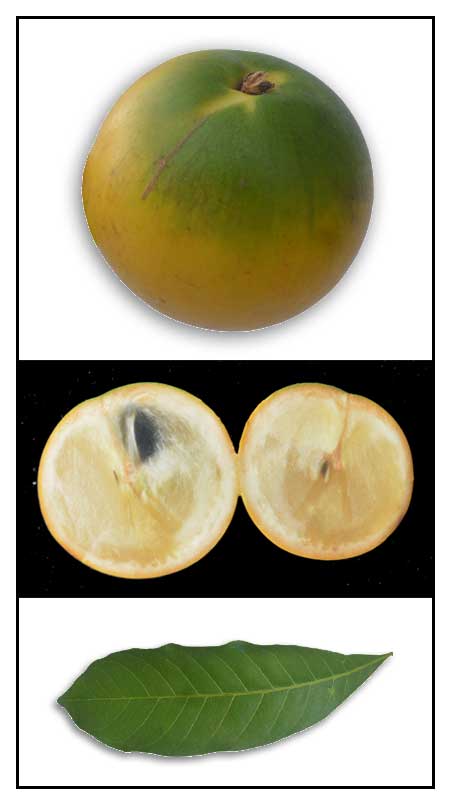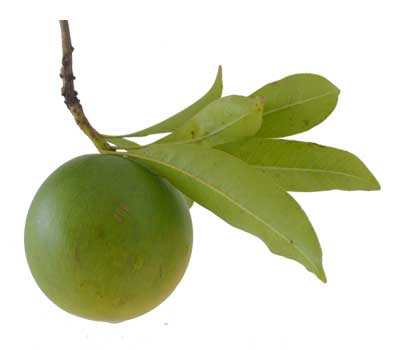 Botany Botany
Abiu is an evergreen tree with a dense crown that grows to a height of 6 to 24 meters; in favorable conditions, as high as 35 meters. Leaves are elliptic to oblong, varying in size from 10 to 20 centimeters in length, 3.5 to 65 centimeters in width. Fruits vary in shape, from spherical to oval; vivid yellow when ripe, containing one to four ovate seeds. Seeds are covered by a thin layer of pulp. Flesh of the fruit is transluscent, with a creamy or custard-like texture, with a flavor hinting of rambutan. Not fully ripe fruits yield a latex that stick to lips. Flowers are hermaphroditic, arising singly or in clusters from leaf axils, borne by slender, elongated shoots. Petals are small, four to five, cylindrical, white to greenish in color. Flowers blossom in the morning and staying open for about two days.
Distribution
- Recently introduced.
- Widely distributed throughout Latin America.
Constituents
- Nutrition analysis per 100 g of edible portion yielded: energy 140 cal (588 kJ), protein 1.8 g, fat 0.4 g, carbohydrate 36.3 g, fiber 0.9 g, ash 0.9 g, calcium 22 mg, iron 1 mg, niacin 34 mg, phosphorus 41 mg, riboflavin 0.02 mg, thiamin 0.02 mg, niacin 3.4 mg, vitamin C 43 mg, vitamin A 130 mg, lysine 316 mg, methionine 178 mg, threonine 219 mg, tryptophan 57 mg. (7)
- Oil components of fruit yielded α-copaene (27.7%) as dominant component, with hexadecy acetate (19.0%), and palmitic acid (12.4%). (7)
- Bark extract yielded taraxerol and ß-sitosterol. (7)
- Benzoic extract of fruit revealed the presence of lupeol, a-amyrin, erythrodiol and the rare tetracyclic triterpene Dammaremdiol II. (5)
 Properties Properties
- Latex hardens on exposure to air.
-
Considered antidiarrheal, febrifuge, anti-inflammatory.
-
Studies suggest antioxidant and antidiabetic properties.
Parts used
Fruit, latex, leaves.
Uses
Edibility
- The fruit has limited commercial value as it is commonly damaged by small insects (bichos in Spanish and Portuguese). In Brazil, the chief pests are fruit flies.
(Fruits are picked while underripe and firm for transport in markets.) (8)
- In Columbia, people who eat the fruit raw and out of hand are advised to grease their lips to prevent the gummy latex from sticking to them.
(8)
- Fruit used in ice cream, sherbets, and fruit salads.
Folkloric
- No reported medicinal use in the Philippines.
- In Brazil,
fruit used for treating coughs, colds, bronchitis, and various pulmonary disorders.
- Latex used for diarrhea and fever; applied to abscesses.
(7) Also used as vermifuge. (8)
- Used as astringent, anti-inflammatory, anti-anemic, febrifuge, and anti-diarrheal.
Others
- Wood: Wood is durable and straight-grained; used for construction.
Studies
• Radical Scavenging Activity / Leaves: Study evaluated various extracts of leaves of Pouteria caimito for radical scavenging activity. The aqueous extract showed the highest total phenol and proanthocyanidin contents (173.6 µg/mL) and highest radical scavenging activity (ED50=38.1 µg/mL. A hexane extract yielded spinasterol. There was a high correlation between total phenolic and proantocyanidin content and radical scavenging activity. (1)
• α-Amylase and α-Glucosidase Inhibitory Activity / Antidiabetic Potential: In a study of several Brazilian plant cerrado species. Pouteria caimito was one of five plant extracts that showed strong α-amylase (IC50=13.6 µg/mL) and α-glucosidase in (IC50=2.50 µg/mL) inhibitory activity. (6)
• Antimicrobial / Antidiarrheal / Fruit Peel: Study evaluated the antimicrobial and antidiarrheal activity of fruit peel extract of Pouteria caimito. In a mice using modulation models of defecation, cathartic agent induced diarrhea and stimulated intestinal transit. The crude extract and ethyl acetate fraction showed satisfactory action against most of the strains evaluated except for Streptotoccus faecalis and Salmonella typhi. The extract did not present any measurable antidiarrheal activity but more possible a laxative effect. (9)
• Cytotoxicity Against Prostate Cancer Cell Lines / Leaves: Study evaluated crude ethanolic extract of P. caimito leases and hexane extract of P. ramiflora i PC3 and LNCap human prostate adenocarcinoma cells. The ethanolic extract of P. caimito showed dose-dependent cytotoxic effect in PC3 cells (>50%) with a statistically significant inhibitory effect on the cell cycle. (10)
Availability
Cultivated.
|

![]()



 Botany
Botany Properties
Properties